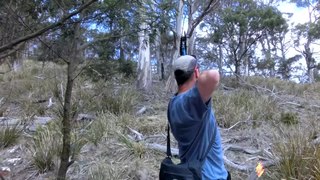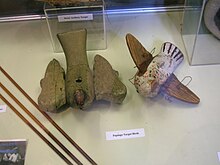
Archery is the sport, practice, or skill of using a bow to shoot arrows. The word comes from the Latin arcus, meaning bow. Historically, archery has been used for hunting and combat. In modern times, it is mainly a competitive sport and recreational activity. A person who practices archery is typically called an archer, bowman, or toxophilite.

Kyūdō is the Japanese martial art of archery. Kyūdō is based on kyūjutsu, which originated with the samurai class of feudal Japan. In 1919, the name of kyūjutsu was officially changed to kyūdō, and following the example of other martial arts that have been systematizing for educational purposes, kyūdō also reorganized and integrated various forms of shooting that had been used up until then. High level experts in kyūdō may be referred to as kyūdōka (弓道家)(Member of the Kyūdō family or house) and some practitioners may refer to themselves as yumihiki (弓引き), or 'bow puller'. Kyūdō is practised by thousands of people worldwide. The bow they use is called a yumi (弓), and the most common one has an asymmetrical shape of more than 2.0 metres, and is characterized by the archer holding the part of the bow below the center to shoot the arrow.

Archery had its debut at the 1900 Summer Olympics and has been contested in 17 Olympiads. 105 nations have competed in the Olympic archery events, with France appearing the most often at 15 times. The most noticeable trend has been the excellence of South Korean archers, who have won 27 out of 39 gold medals in events since 1984. It is governed by the World Archery Federation. Recurve archery is the only discipline of archery featured at the Olympic Games. Archery is also an event at the Summer Paralympics.
The Antient Scorton Silver Arrow is an archery tournament that was incepted on Sunday 14 May 1673 in the village of Scorton in Yorkshire, England. Twenty-two archers competed in the first event for the prize of a silver arrow. This was won by Henry Calverley of Eryholme on Tees, who had provided the trophy. The event proved so successful that a new organisation, the Society of Archers, was formed to hold the event on an annual basis.
At the 2008 Summer Olympics, the Archery competitions were held between 9 August and 15 August, at the Olympic Green Archery Field, a temporary venue on the Olympic Green, Beijing's Olympic Park.

Target archery is the most popular form of archery, in which members shoot at stationary circular targets at varying distances. All types of bow – longbow, barebow, recurve and compound – can be used. In Great Britain, imperial rounds, measured in yards, are still used for many tournaments and these have slightly different rules to metric (WA) rounds, which are used internationally. Archers are divided into seniors and juniors, with juniors being those under the age of 21.
Archery GB is the largest national governing body for the sport of archery in the United Kingdom. Archery GB is responsible for all levels of archery within the UK from elite to development level and supports over 40,000 members. Archery GB is the umbrella organisation for English Archery Association, Archery Northern Ireland, Scottish Archery and Welsh Archery Association. Under Archery GB are eight Regional Societies and many different county societies. It is affiliated to the World Archery Federation (WA); and is a member of the British Olympic Association. The society's motto is: "Union, Trueheart and Courtesie".

Field archery is any archery discipline that involves shooting at outdoor targets of varying and often unmarked distance, typically in woodland and rough terrain.

Clout archery is a form of archery in which archers shoot arrows at a flag from a relatively long distance and score points depending on how close each arrow lands to the flag.
The Olympic Round was introduced to target archery so that it could become more watchable as a competitive sport, the main focus of this being for the Olympics when shown on television. The round was developed by the World Archery Federation. It is used at the Olympic Games, the Archery World Cup and in many lower profile or local tournaments.

An arbalist, also spelled arbelist, is one who shoots a crossbow.

The girls' individual archery event at the 2010 Summer Youth Olympics was held from 18 to 20 August 2010 at the Kallang Field in Kallang, Singapore. It was one of three recurve archery events which comprised the archery programme at the inaugural Summer Youth Olympics, and featured thirty-one archers from thirty-one countries. Entry was open to female archers born between 1 January 1992 and 31 December 1993.
Modern competitive archery involves shooting arrows at a target for accuracy and precision from a set distance or distances. This is the most popular form of competitive archery worldwide and is called target archery. A form particularly popular in Europe, North America, and South America is field archery, shot at targets generally set at various distances in a wooded setting. There are also several other lesser-known and historical forms, as well as archery novelty games.

The archery events at the 2016 Summer Olympics in Rio de Janeiro were held over a seven-day period from 6 to 12 August. Four events took place, all were staged at the Sambadrome Marquês de Sapucaí.

The archery events at the 2020 Summer Olympics in Tokyo took place in Yumenoshima Park. Five events were planned with a mixed team event staged for the first time.

Shooting targets are objects in various forms and shapes that are used for pistol, rifle, shotgun and other shooting sports, as well as in darts, target archery, crossbow shooting and other non-firearm related sports. The center is often called the bullseye. Targets can for instance be made of paper, "self healing" rubber or steel. There are also electronic targets that electronically can provide the shooter with precise feedback of the shot placement.

The men's individual archery event was one of five archery events at the 2020 Summer Olympics. It was held at Yumenoshima Park. There were 64 competitors from 40 nations, with nations having either 1 or 3 archers.

The women's individual archery event was one of five archery events held at the 2020 Summer Olympics. It was held at Yumenoshima Park. There were 64 competitors from 40 nations, with each nation having either 1 or 3 archers.

The women's team archery event was one of five archery events held at the 2020 Summer Olympics. It was held at Yumenoshima Park, with the ranking round taking place on 23 July and match play on 25 July.

The archery competitions at the 2024 Summer Olympics in Paris are scheduled to run over a seven-day period, from 25 July to 4 August, at Les Invalides. 128 archers will compete across five events, with the successful mixed team recurve returning to the Olympic program for the second time.

















